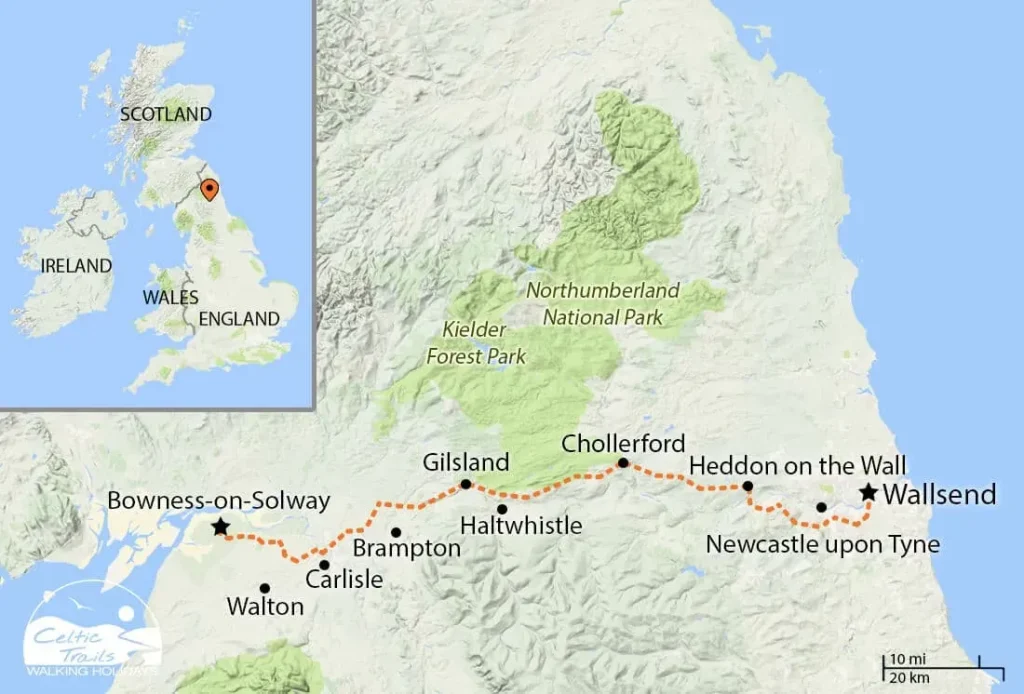The Hadrian’s Wall path is a remarkable journey through time, stretching 84 miles across northern England and offering a unique blend of natural beauty and rich Roman history. As one of the most iconic national trails in the UK, this hike invites adventurers to explore the remnants of an ancient empire, brought to life by the stunning landscapes of the Cumbrian coast and beyond. Established under Emperor Hadrian in AD 122, the trail showcases well-preserved ruins and breathtaking vistas, providing a captivating experience for history buffs and nature lovers alike. Hiking along the Hadrian’s Wall path means walking in the footsteps of Roman soldiers, evoking a deep sense of connection to the past. Whether you’re a seasoned walker or just beginning to explore the joys of Hadrian’s Wall walking, this trail promises an unforgettable adventure steeped in archaeological treasures and stunning scenery.
Discover the captivating Hadrian’s Wall trail, an extraordinary walking route that unveils the intriguing stories of Roman civilization in England. This historic footpath traces the line of defensive structures that once marked the northern limit of the Roman Empire, offering hikers an opportunity to immerse themselves in the scenic landscapes and historical marvels of the area. Known for its rugged terrain and archaeological significance, the Hadrian’s Wall hike combines the thrill of outdoor adventure with lessons from the past. As you traverse the vibrant paths of this renowned National Trail, you will not only enjoy the natural beauty but also gain insights into the multi-layered history that defines this remarkable region. Step onto the Hadrian’s Wall pathway and embark on an adventure that celebrates the enduring legacy of Roman engineering and cultural influence.
Exploring the Hadrian’s Wall Path: A Journey through Roman History
Walking the Hadrian’s Wall Path is not just a hike; it’s a journey into the heart of Roman history in England. Spanning 84 miles, this splendid trail offers hikers an unparalleled opportunity to explore remnants of the past that date back to AD 122. The path weaves through breathtaking landscapes, inviting adventurers to explore forts, milecastles, and ditches that tell tales of the Roman Empire’s attempts to secure its borders against the raiding tribes of the north. With each step, one can almost hear the echoes of soldiers marching along the wall, providing a vivid connection to the ancient world.
The charm of the Hadrian’s Wall Path lies in its diversity. From rugged moorlands to picturesque valleys, the scenery mirrors the tumultuous history it represents. As walkers traverse the trail, they are rewarded with panoramic views and the chance to encounter the archaeological treasures scattered along the route. This is what makes walking this national trail a unique experience—immersed in both the natural beauty of England and the rich tapestry of its Roman history.
The Allure of the Cumbrian Coast: Linking Nature and History
Along the western stretch of Hadrian’s Wall, the Cumbrian coast plays a pivotal role in the overall experience. Kicking off at Bowness-on-Solway, hikers are treated to breathtaking coastal vistas where sea and land converge in dramatic fashion. The ditches and fortifications along the coastline were strategically placed to ensure that intruders could not easily outflank the Wall’s defenses. It’s a walk that brings to life the historical battles and the relentless spirit of the Romans as they established their presence in these distant lands.
This segment also highlights the stark contrast between the tranquility of the coastal views and the turmoil of historical conflicts. As one wanders through this area, the haunting remnants of fortifications whisper stories of the Reivers, the marauding raiders who once roamed these parts. The natural beauty of the Cumbrian coast coupled with its deep historical roots provide an enriching experience for those wishing to merge their love of hiking with a profound appreciation for England’s heritage.
Camping Adventures Along Hadrian’s Wall: Embracing the Wild Spirit
Camping along the Hadrian’s Wall path presents a unique opportunity to engage intimately with the landscape. For those like me who prefer wild camping, the choice to set up a tent discreetly near the historical ruins only adds to the adventure. Each evening spent under the stars serves as a reminder of the countless travelers who tread this land over centuries, envisioning the encounters between the Roman legions and the local tribes. With a backpack filled with essentials and the thrill of wilderness, every moment spent on this path holds a sense of discovery and solitude amidst the echoes of history.
While the romance of camping out is irresistible, it also requires careful planning to navigate the terrain and the unpredictable weather of Northern England. As I discovered, a biting gale can challenge even the most seasoned backpacker’s resolve. However, these elements only enhance the authenticity of the experience. To stand at the edge of the Wall, tent pitched nearby, with a sense of the historical significance surrounding me, allows for a transformative journey where nature reinforces the raw spirit of adventure.
The Historic Significance of Birdoswald Fort
Birdoswald Fort represents one of the most fascinating segments of the Hadrian’s Wall path, showcasing the strategic military architecture of the Roman Empire. As hikers approach this well-preserved site, they witness the remnants of granaries, barracks, and defensive walls that crafted a fortified stronghold against potential threats. The fort’s impressive construction offers insights into the daily lives of Roman soldiers, highlighting their needs for shelter and sustenance while on guard.
The site’s historic significance extends beyond its physical attributes; it symbolizes the Roman commitment to fortifying their empire. As I walked through Birdoswald, the sense of history enveloped me, allowing a vivid mental image of Roman life—a bustling community anchored in purpose at the northern edge of the Empire. This juxtaposition of the historical with the present offers a profound understanding of the challenges faced by the Romans as they sought to expand their territory, making Birdoswald a compelling waypoint on any Hadrian’s Wall journey.
Hadrian’s Wall Path: A Testament to Roman Engineering
Walking the Hadrian’s Wall Path reveals an extraordinary feat of engineering, demonstrating the Romans’ capacity to manipulate the landscape for defensive purposes. The wall itself, built from rough-hewn stones, once stood tall as a formidable barrier against invading forces. As I trekked along the route, the remnants of walls and ditches served as markers of this monumental achievement, compelling modern hikers to marvel at the skills and dedication of those who toiled under the Roman banner.
Moreover, this national trail embodies more than just an ancient boundary; it reflects the organization and efficiency synonymous with the Roman administration. Understanding how these systems worked in tandem to create a cohesive force helps hikers appreciate better the operational logistics behind maintaining such an extensive frontier. The remnants one encounters while walking Hadrian’s Wall inspire admiration and respect for the engineering brilliance that characterized the Roman Empire.
Experiencing the Pennine Way: Connections Beyond Hadrian’s Wall
The Pennine Way, another iconic national trail, intersects with the Hadrian’s Wall path, adding a layer of intrigue for avid walkers. This connection allows hikers to experience not only the rich heritage of the Roman Empire but also the natural beauty of the Pennine Hills. As I navigated this section, the rugged, undulating terrain stood in stark contrast to the historical remnants of walls, inviting reflections on the passage of time and the stories held within.
This intertwining of trails reinforces the concept of long-distance walking as a way to engage with history on multiple levels. Both the Hadrian’s Wall and Pennine Way paths highlight the challenges faced by adventurers, both ancient and modern, showcasing the resilience required to traverse these landscapes. This dual experience becomes a celebration of the natural world and the cultural narratives that emerge through exploration—a recipe for creating lasting memories.
The Scenic Wonders Along Hadrian’s Wall Path
The scenic wonders that accompany the Hadrian’s Wall Path cannot be overlooked. Along the varying landscapes, from lush valleys to craggy hilltops, walkers are treated to visual feasts of rolling hills and the dramatic Northumberland scenery. The backdrop of these views serves as a constant reminder of nature’s influence on historical events, enriching every step along the trail. Each vista evokes a deeper exploration of how geography shaped human endeavors, particularly in the context of the Roman expansion into Briton.
Nature plays a pivotal role in the walking experience, often encapsulating the spirit of the journey itself. As the light waxes and wanes throughout the day, the changing landscapes offer up a palette of colors and moods. This shifting backdrop encourages introspection, allowing one to ponder not only the natural beauty but also the historical weight of this ancient path. Such immersion within the landscape deepens the appreciation for the interplay between man and nature, creating a holistic hiking experience on the Hadrian’s Wall Path.
Reflections on Newcastle and the End of the Journey
Reaching Newcastle at the end of the Hadrian’s Wall Path marks both a culmination of the journey and a deep reflection on the experiences gathered along the way. The city, bustling and modern, stands in stark contrast to the ancient ruins found along the trail. As I strolled along the Tyne, surveying the urban landscape, it became clear that history continues to shape the present in profound ways. The fading echoes of Roman legions mingled with the sounds of contemporary life, creating a rich tapestry of culture and history.
Moreover, the journey along Hadrian’s Wall is a reminder of how significant stories and structures persist through time. As I stood at Wallsend, contemplating the terminus of the wall, it became evident that this path transcends simple geography; it embodies the enduring nature of human aspirations. Engaging with the remnants of Roman history brings forth a renewed appreciation for the interconnectedness of our past and present—an enriching journey that culminates in the lively city of Newcastle.
The Legacy of Hadrian’s Wall: Lessons from the Past
The legacy of Hadrian’s Wall offers lessons that reverberate through time. As a defining structure of the Roman Empire, it serves as a physical reminder of the power dynamics, cultural exchanges, and the quest for security that shaped the ancient world. Throughout the hiking experience, this legacy becomes increasingly evident, challenging walkers to contemplate the complexities of history and the enduring impact of the Roman presence in Britain. Each stone in the wall tells a story of labor, ambition, and the inherent human desire for safety.
This enduring impact invites a deeper understanding of cultural continuity and change. While empires may rise and fall, the structures they leave behind continue to shape landscapes and inform the cultural identities of those who inhabit them. Engaging with Hadrian’s Wall encourages reflection on the responsibilities of historical preservation and the importance of storytelling in keeping histories alive. The path itself becomes an opportunity to learn from the past while considering the implications for our future.
Frequently Asked Questions
What can I expect while hiking Hadrian’s Wall Path?
When hiking Hadrian’s Wall Path, expect a diverse landscape that showcases the beauty of both natural scenery and significant historical sites. The trail offers 84 miles of walking through the remains of Roman history in England, with sections of the wall still intact along with forts, milecastles, and stunning vistas of the nearby countryside. You will experience varying terrains, from flat coastal paths at Bowness-on-Solway to rugged moorlands near Housesteads.
Is the Hadrian’s Wall path suitable for beginners?
Yes, the Hadrian’s Wall path is suitable for beginners, although it does involve some challenging sections. The trail is well-marked and generally accessible, making it a great introduction to long-distance walking in the UK. Beginners should prepare for diverse weather conditions and bring appropriate gear, as part of the trail travels through remote areas.
How long does it take to complete the Hadrian’s Wall hike?
Most walkers complete the Hadrian’s Wall hike in about 6 to 7 days, averaging 10-12 miles per day. However, the duration can vary based on individual fitness levels and weather conditions. Many hikers enjoy taking their time to explore the rich Roman history and breathtaking landscapes along the way.
What should I bring for a journey on the Hadrian’s Wall walking trail?
When walking the Hadrian’s Wall trail, pack light but include essential gear such as a sturdy pair of walking boots, weather-appropriate clothing, a sleeping bag if you plan to camp, a first aid kit, and ample water and snacks. Since some sections are remote, consider also bringing navigation tools like a map or GPS device to help guide you.
Are there accommodations available along the Hadrian’s Wall path?
Yes, there are various accommodations available along the Hadrian’s Wall path, ranging from campsites for wild camping to hostels and bed-and-breakfast establishments. Booking in advance is recommended, especially during peak walking season, to ensure you secure a spot that suits your needs.
What historical sites should I visit while walking Hadrian’s Wall?
While walking Hadrian’s Wall, key historical sites include Housesteads Fort, which offers insights into Roman life, the well-preserved remains at Birdoswald, and Carlisle Cathedral near the trail’s midpoint. Don’t miss the picturesque views from Sycamore Gap, famed from the film Robin Hood: Prince of Thieves, and the Segedunum Fort at Wallsend, marking the end of your journey.
Can you walk the Hadrian’s Wall path year-round?
Although you can technically walk the Hadrian’s Wall path year-round, the best time to hike is between April and September. During this period, the weather is generally milder, and the trail is less prone to muddy conditions. Winter hikes can be challenging due to rain, snow, and colder temperatures.
What wildlife can I expect to see on the Hadrian’s Wall path?
The Hadrian’s Wall path is home to a variety of wildlife, including birds such as peregrine falcons and lapwings, as well as mammals like deer and otters along the rivers. Walking through the diverse landscapes, you may also encounter many species of butterflies and wildflowers, which add to the trail’s natural beauty.
Are there any guided tours available for the Hadrian’s Wall walk?
Yes, there are guided tours available for the Hadrian’s Wall walk, offering expert insights into the area’s Roman history and geology. Guided tours can enhance your experience by providing historical context and ensuring you don’t miss key sites along the trail.
What are the challenges of walking the Hadrian’s Wall path?
Challenges when walking the Hadrian’s Wall path may include dealing with unpredictable weather, varied terrain, and some steep sections, particularly near Housesteads Fort. Additionally, parts of the path may have limited access to facilities, requiring hikers to be self-sufficient in terms of food and water.
| Key Points |
|---|
| Hadrian’s Wall Path stretches 84 miles from Bowness-on-Solway to Wallsend, marking the Roman Empire’s north-west frontier. |
| Built under Emperor Hadrian in AD 122, it showcases Roman engineering and military history. |
| The path has received both anniversary recognition and increased attention for its archaeological significance. |
| A combination of wild camping and occasional hostel stays enhances the immersive experience of the trail. |
| Key landmarks like Housesteads Fort, Carlisle Castle, and Sycamore Gap present historical and scenic vistas. |
| The trail’s theme is about reconnection with history, nature, and personal reflection. |
| Concluding at Segedunum Fort in Wallsend, it emphasizes the enduring impact of Roman civilization. |
Summary
The Hadrian’s Wall path is a remarkable journey that traces the remnants of the Roman Empire, inviting walkers to explore both historical ruins and breathtaking landscapes. Spanning 84 miles from Bowness-on-Solway to Wallsend, this trail offers a unique blend of adventure, history, and cultural reflection. As you walk along this iconic path, you not only connect with the rich past of Roman landscapes and engineering but also embrace the challenging and rewarding experience of wild camping amid the stunning scenery. Ultimately, the Hadrian’s Wall path serves as a powerful reminder of the legacies left by ancient civilizations, providing a transformative experience for every hiker.



